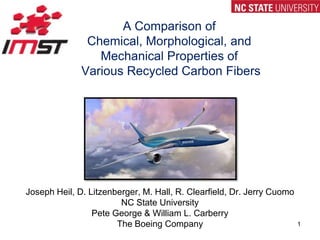Recylced Carbon FIber Analysis 2009
- 1. A Comparison of Chemical, Morphological, and Mechanical Properties of Various Recycled Carbon FibersJoseph Heil, D. Litzenberger, M. Hall, R. Clearfield, Dr. Jerry CuomoNC State UniversityPete George & William L. CarberryThe Boeing Company1
- 2. PreviewHow to study recycled carbon fibersFiber type & source materialResultsConclusion2
- 6. SEM-Fiber DiameterStandard ModulusImage Analysis software used to measure fiber diameter6
- 7. SEM-Fiber DiameterOverall no dramatic reductionsVariation between fiber lots 7IM T800sIM Hexcel IM7* Most significant change ~8% diameter decrease
- 8. SEM- Hexcel IM78Reclaimed by Milled Carbon from BMI cured trim scrapCIndications of:Pitting
- 9. Char
- 10. Grooved surfaceDiameter :Virgin > RecycledVirgin IM7
- 11. I-MC-CTS Cross Sections9Cross sectioning done with FIB-Protective coating of PtPits are shallow relative to bulkUndamaged X-Section10Light Surface texturing
- 12. Toray T800s (IM)11Milled CarbonV T800sUnidirectional trim scrap from uncured prepregDiameter decrease
- 13. Evidence of pitting but otherwise cleanT-800s SEM ImagesFibers are clean no visible damage ENEA/ Karborek LabENEA/ Karborek PilotCured Trim ScrapLoosely boundMilled Carbon Cured Trim ScrapVirgin T800s 12
- 14. 13A-RCF9T300 SM FibersThick crenulations, considerable junk on surfaceStriations more evident than virgin fiberVirgin â characteristic striationsA- Cured Trim ScrapA & B reclaimed by Milled CarbonDiameter:A>B>C B- Uncured Trim ScrapC-V T300H
- 15. SEM DiscussionMinimal changes in diameterPitting observed on IM fibersDifficult to identify surface materialSEM analysis is informative & efficient14
- 16. XPS Discussion Used to determine atomic percentages% bondingSignificant surface activity for chemical bondingActivity comparable to unsized virgin fiber15
- 17. TensileStrength16T300AS4Favorable strength retention at shorter gauge lengths
- 18. T300 cured trim scrap fibers were too brittle to testElastic Modulus17T300AS4Source material: EOL scrapSource material: uncured trim scrapIncrease modulus with increase in gauge length
- 19. Fibers remain stiff after recyclingT800s Tensile Strength18Large reduction in strength with increase in gauge length.
- 20. Reasonable retention at 6mm gauge lengthT800s Elastic ModulusSmall variation in modulus with gauge length
- 21. Fibers remain stiff after recycling19
- 22. Tensile Test SummaryStrength retention:<0.25in: 90%~1in: 80%2+in: 60%-70%Modulus increases with gauge lengthHigh modulus retentionFlaw distribution sensitivity20
- 23. Single Fiber Composite Test21Reasons for increased adhesion:Surface chemistry
- 24. Surface roughnessCTS lab CTS pilot Virgin UC CTSVirgin MC-UTSVirgin EOL EOL-OENEA/ KarborekMilled CarbonMilled CarbonFibers show excellent retention or increase in IFSSConclusionsNC State has developed a methodology to evaluate CFsFiber diameter measurements can indicate residual char or oxidationXPS shows surface favorable for bondingSM fibers have better strength retention than IMRecycled IM stronger than virgin SMRecycled fibers retain high level of performance22
- 25. AcknowledgmentsThe Boeing CompanyMilled Carbon Ltd (Recycled Carbon Fiber Ltd.)Adherent TechnologiesDr. Anil NetravaliIMST-NCSUKa Wong & Chuck Mooney- NCSU AIF23
- 26. Toray T800s (IM)24Reclaimed by Milled CarbonV T800sUncureda) Characteristic air gap spun precursor b) Residue noticeable on surface. Similar to residue found on recycled T700G.Diameter :Virgin > Recycled
- 27. XPS of Virgin Fibers25Fibers were supplied with Epoxy Size except V AS4
- 28. V AS4 most representative
- 29. High degree of Hydroxyl groupsXPS of IM fibers26V T800s T8MCUC T8_CTSa T8_CTSb T8MCCTST8MCUC T8_CTSa T8_CTSb T8MCCTSVirgin fiber shows lower carbon content because of sizing
- 30. RCF show mostly carbon & oxygen
- 31. Surface chemistry is more variable
- 32. Graphitic and hydroxyl bonding predominateXPS of SM Fibers27T300T300IM7IM7T300T300IMCEOL T3MCUTS T3MCCTS VIM7 IMCEOL VT300 MCUTS MCCTS
Editor's Notes
- #3: Why carbon fiber recycling
- #7: 2 sig fig
- #8: 2 sig fig
- #10: Might be preexisting; measure debth; Gallium ion beam
- #13: Decrease in diameter for Fibers on left. CTSb ~ equal diameter
- #14: B& C cytec âA Toray or Cytec
- #19: Extrapolated
- #22: Performed at Cornell University under direction of Dr. Netravali
- #23: Trends!
- #26: Kratos Spot size 170x300 um?
- #27: Make fonts in graphs the same


























